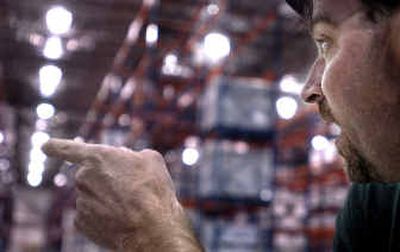Feeding a big appetite

POST FALLS – Most local residents will get a regular taste of Sysco Food Services, even though the region’s newest food warehouse isn’t open to the public.
The warehouse will act as a grocer to area restaurants, hospitals, schools and nursing homes.
“We buy product by the pallet load, and send it out by the case or by the ‘each’ – three cantaloupe each, or six heads of lettuce each,” said Layton Rosencrance, Sysco’s general manager in Spokane.
The warehouse, a giant white rectangle visible from Interstate 90, opens April 4. Employees are already working to stock the 164,000-square-foot building, which will carry about 8,000 different items, from frozen french fries to imported olive oil.
Fresh produce, meats, seafood, canned goods, frozen and dry foods are warehouse staples. Orders of paper napkins, cleaning supplies, dishes and utensils will also go out of the facility.
Houston-based Sysco is one of the nation’s largest food distributors, with annual sales of more than $21 billion. The company, founded in 1970, was a pioneer in “broad-line” distribution, the concept of one supplier providing individual restaurants with all their food items.
The new warehouse will serve customers in parts of three states. “We go from Wallace to Wenatchee, and from Ponderay to Pendleton,” Rosencrance said.
Before, those orders were filled at Sysco warehouses in Portland, Boise and Kent, Wash. About 100 people will work at the Post Falls facility when hiring is completed. Inside its utilitarian facade, the $20 million warehouse is a marvel of sophisticated computer tracking. Each case of food or dry goods gets a yellow bar code when it arrives. The bar codes help with inventory control in the cavernous dry goods section, where cases are stacked on scaffolding, and in the freezer section, where temperatures range from 55 degrees in the vegetable cooler to 20 degrees below zero in the ice cream section.
“There’s a lot of technology involved,” said Stan Handel, operations systems analyst.
A machine called a Cubitron calculates the cubic dimensions of each product, and figures out where space is available in the warehouse to store it. Night-shift employees, who fill out-going orders, wear wrist bands with small computers. The computers locate products in the warehouse, and the scanners ensure that employees aren’t mistakenly filling orders for onion rings with okra.
Accuracy is critical in the business, Handel said. Sysco’s goal is one mistake or less for every 6,000 to 10,000 cases shipped.
“It’s all about getting the right product to the customer at the right time, in the right condition,” Rosencrance said.
Tracking is also critical. The warehouse will go through 10 to 12 different governmental and agency food-safety inspections this year, said Greg Hendrickson, Sysco’s night operations manager. Inspectors will spend hours poring over records.
“We can trace every clam back to the clam bed it came out of,” Hendrickson said.
In addition to storage space, the warehouse contains a culinary center. This week, food brokers are set up in the kitchen, giving demonstrations of new items to potential customers.
“Being Sysco, we have access to a lot of information about trends in the restaurant business,” Rosencrance said.
One of the hottest trends right now is seafood. Lots of restaurants are incorporating a seafood entrée or two into their menus, Rosencrance said.